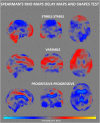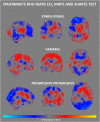Regional Cerebral Perfusion and Cerebrovascular Reactivity in Elderly Controls With Subtle Cognitive Deficits
- PMID: 30837863
- PMCID: PMC6390712
- DOI: 10.3389/fnagi.2019.00019
Regional Cerebral Perfusion and Cerebrovascular Reactivity in Elderly Controls With Subtle Cognitive Deficits
Abstract
Background: Recent studies suggested that arterial spin labeling (ASL)-based measures of cerebral blood flow (CBF) as well as cerebral vasoreactivity to CO2 (CVR CO2) show significant alterations mainly in posterior neocortical areas both in mild cognitive impairment (MCI) and Alzheimer disease. It remains, however, unknown whether similar changes occur in at risk healthy elders without clinically overt symptoms. This longitudinal study investigated patterns of ASL perfusion and CVR CO2 as a function of the cognitive trajectories in asymptomatic elderly individuals. Methods: Seventy-nine community-dwelling subjects (mean age: 78.7 years, 34 male) underwent three neuropsychological assessments during a subsequent 3-year period. Individuals were classified as stable-stable (SS), variable (V), or progressive-progressive (PP). Between-group comparisons were conducted for ASL CBF and transit-time delay maps and β-maps of CO2 response. Spearman's rho maps assessed the correlation between ASL (respectively, CVR CO2 measures) and Shapes test for working memory, as well as Verbal fluency test for executive functions. Three group-with-continuous-covariate-interaction designs were implemented to investigate group-based differences on the association between neuropsychological scores and ASL or CO2 measures. Results: Comparison of CBF maps demonstrates significantly lower perfusion in the V-group as to PP-cases predominantly in parietal regions, including the precuneus and, to a lesser degree, in temporal and frontal cortex. A stronger CVR CO2 response was found in the PP-group in left parietal areas compared to the V-group. V-cases showed a stronger ASL-Shape value relationship than V-group in right temporoparietal junction and superior parietal lobule. CO2-Shape value correlation was significantly higher in both SS and PP-groups compared to the V-group in right insular and superior perisylvian regions. Conclusion: Our data indicate the presence of decreased ASL and CVR CO2 values mainly in parietal and fronto-temporal areas in cases with the first signs of cognitive instability (V-group). Importantly, the PP-group, at high risk for MCI transition, displays an increase of both parameters in the same areas. Clinicoradiologic correlations also indicate a clear distinction between the V-group and both PP and SS-cases. These data imply the presence of an inverted U-shape pattern of regional blood flow and CVR in old age that might predict subsequent cognitive fate.
Keywords: CO2; arterial spin labeling; asymptomatic controls; brain perfusion; cerebrovascular reactivity; clinicoradiologic correlations.
Figures






Similar articles
-
Arterial spin labelling reveals prolonged arterial arrival time in idiopathic Parkinson's disease.Neuroimage Clin. 2014 Aug 1;6:1-8. doi: 10.1016/j.nicl.2014.07.014. eCollection 2014. Neuroimage Clin. 2014. PMID: 25379411 Free PMC article.
-
Changes in cerebral blood flow and vasoreactivity to CO2 measured by arterial spin labeling after 6days at 4350m.Neuroimage. 2013 May 15;72:272-9. doi: 10.1016/j.neuroimage.2013.01.066. Epub 2013 Feb 4. Neuroimage. 2013. PMID: 23384523
-
Relationship between Cerebral Perfusion on Arterial Spin Labeling (ASL) MRI with Brain Volumetry and Cognitive Performance in Mild Cognitive Impairment and Dementia due to Alzheimer's Disease.Ann Indian Acad Neurol. 2021 Jul-Aug;24(4):559-565. doi: 10.4103/aian.AIAN_848_20. Epub 2021 Apr 5. Ann Indian Acad Neurol. 2021. PMID: 34728951 Free PMC article.
-
Aberrant pattern of regional cerebral blood flow in mild cognitive impairment: A meta-analysis of arterial spin labeling magnetic resonance imaging.Front Aging Neurosci. 2022 Sep 1;14:961344. doi: 10.3389/fnagi.2022.961344. eCollection 2022. Front Aging Neurosci. 2022. PMID: 36118708 Free PMC article.
-
Cerebral Blood Flow Alterations in Type 2 Diabetes Mellitus: A Systematic Review and Meta-Analysis of Arterial Spin Labeling Studies.Front Aging Neurosci. 2022 Feb 16;14:847218. doi: 10.3389/fnagi.2022.847218. eCollection 2022. Front Aging Neurosci. 2022. PMID: 35250549 Free PMC article.
Cited by
-
Cerebrovascular reactivity MRI as a biomarker for cerebral small vessel disease-related cognitive decline: Multi-site validation in the MarkVCID Consortium.Alzheimers Dement. 2024 Aug;20(8):5281-5289. doi: 10.1002/alz.13888. Epub 2024 Jul 1. Alzheimers Dement. 2024. PMID: 38951718 Free PMC article.
-
Altered serum amyloid beta and cerebral perfusion and their associations with cognitive function in patients with subcortical ischemic vascular disease.Front Neurosci. 2022 Oct 13;16:993767. doi: 10.3389/fnins.2022.993767. eCollection 2022. Front Neurosci. 2022. PMID: 36312019 Free PMC article.
-
The same, but different: Preserved distractor suppression in old age is implemented through an age-specific reactive ventral fronto-parietal network.Hum Brain Mapp. 2020 Oct 1;41(14):3938-3955. doi: 10.1002/hbm.25097. Epub 2020 Jun 23. Hum Brain Mapp. 2020. PMID: 32573907 Free PMC article.
-
Improvement of Retinal Microcirculation after Pulmonary Vein Isolation in Patients with Atrial Fibrillation-An Optical Coherence Tomography Angiography Study.Diagnostics (Basel). 2021 Dec 24;12(1):38. doi: 10.3390/diagnostics12010038. Diagnostics (Basel). 2021. PMID: 35054205 Free PMC article.
-
Arterial spin labeling perfusion MRI in the Alzheimer's Disease Neuroimaging Initiative: Past, present, and future.Alzheimers Dement. 2024 Dec;20(12):8937-8952. doi: 10.1002/alz.14310. Epub 2024 Oct 21. Alzheimers Dement. 2024. PMID: 39428971 Free PMC article. Review.
References
LinkOut - more resources
Full Text Sources
Miscellaneous

